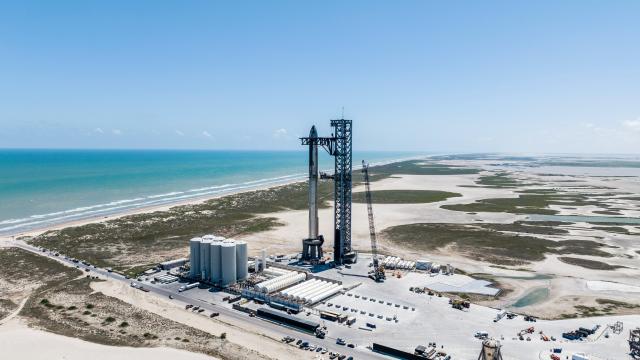The stacking of Starship’s upper stage 25 onto booster 9 was completed on September 5 at SpaceX’s Starbase facility in Boca Chica, Texas. With the megarocket now standing tall at the launch mount, SpaceX announced its readiness for the second launch, though FAA approval remains outstanding.
On Tuesday, SpaceX CEO Elon Musk Elon Musk confirmed the company’s preparation on X, formerly Twitter, stating: “Starship is ready to launch, awaiting FAA license approval.” For better or worse, Starship’s second flight promises to be another spectacle. However, in light of the first attempt’s events, the federal regulator is aiming for a more subdued outcome.
Indeed, the maiden flight faced a series of complications. Starship was airborne for approximately four minutes before entering into an unexpected fatal tumble, necessitating a self-destruct command by ground controllers. Contributing factors to the misstep included multiple Raptor engine failures and booster issues. Furthermore, the absence of a blast suppression system at the launch pad resulted in significant damage and the spread of debris in the vicinity. In the wake of the botched flight, conservation groups mounted a lawsuit against the FAA for approving the launch.
In response to the previous flight’s outcomes, SpaceX has taken considerable measures to refine the giant rocket. Among the numerous modifications, which Musk mentioned to be “well over a thousand,” two are worthy of note.
Firstly, SpaceX has opted for a “hot-staging approach” in which the engines in the rocket’s upper stage will ignite before separating from the booster. This adjustment will not only enhance performance—it has also added 6 feet (1.8 meters) to Starship’s height, taking it to a total of 400 feet (122 meters), as NASASpaceflight reports.
Secondly, improvements have been made to the rocket’s flight termination system, which didn’t work as planned during the inaugural launch; it took 40 seconds for the self-destruct command to activate—an interminable delay for such a critical safety feature. In the wake of the first launch, SpaceX has also constructed and tested a launch pad water deluge system, reminiscent of a bidet, to mitigate future damages.
As of now, the FAA holds the key to the next test flight. “The SpaceX Starship mishap investigation remains open,” the regulator explained in a statement. “The FAA will not authorize another Starship launch until SpaceX implements the corrective actions identified during the mishap investigation and demonstrates compliance with all the regulatory requirements of the license modification process.”
Clear, concise, and straight to the point.
For this upcoming flight, the date of which (obviously) is yet to be determined, Starship will not carry any payloads. The mission’s primary objectives are to evaluate the new stage separation technique, ensure maximum Raptor engine reliability (out of the 33 total engines), and accomplish nearly three-quarters of a trip around Earth, with the upper stage projected to splash down near the Hawaiian island of Kauai in the Pacific ocean.
Related article: SpaceX Starship Woes Have NASA Worried About Artemis Moon Landing Delays
The stakes are high, especially given NASA’s reliance on Starship. The space agency is looking to integrate SpaceX’s Starship into its Artemis program, aiming to land astronauts on the Moon for the Artemis 3 mission currently slated for 2025. Beyond these contracts, NASA envisions Starship’s potential in lunar cargo deliveries and possibly playing a role in the construction of the lunar Gateway space station.
Want to know more about Elon Musk’s space venture? Check out our full coverage of SpaceX’s Starship megarocket and the SpaceX Starlink internet satellite megaconstellation. And for more spaceflight in your life, follow us on Twitter and bookmark Gizmodo’s dedicated Spaceflight page.
